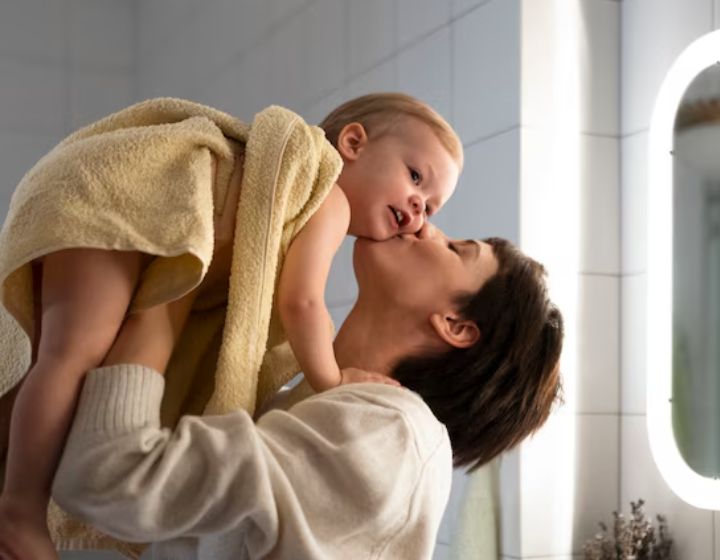
 Post Category - ParentingParenting - Post Category - BabyBaby - Post Category - Toddler & PreschoolerToddler & Preschooler
Post Category - ParentingParenting - Post Category - BabyBaby - Post Category - Toddler & PreschoolerToddler & PreschoolerBathtime is more than just hygiene. Parenting coach Swetha Vigraham explains when parents can let go of the reins and how it teaches important lessons in independence, body respect, and personal boundaries.
When my son was born, I received three baby rockers as gifts from friends. Like many new parents, I learned the importance of better communication to avoid duplicates. But since I had three, I made the best of them: one as a dining chair, another as a naptime bed, and the last—most unusually—as a bathing buddy.
Yes, one of the rockers found its home next to the glass shower partition. My son, like many babies, had an uncanny ability to sense when I was showering. Even if he was napping, the sound of water would wake him, and he’d cry inconsolably until he could see me through the glass. This began our unique bathing adventures.
As my workload increased, so did my son’s hours in childcare. To compensate for missing playtime, I created two sacred routines: his bath time and bedtime. These moments became our special bonding rituals, filled with giggles, bubbles, and heartwarming questions.
Until one day, as he threw a curious question about my body, I realised it was time to respect both our privacies. It was time for him to start bathing independently.
Read more: How To Talk To Kids About Their Bodies & Inappropriate Touch
How do you know your child is ready?
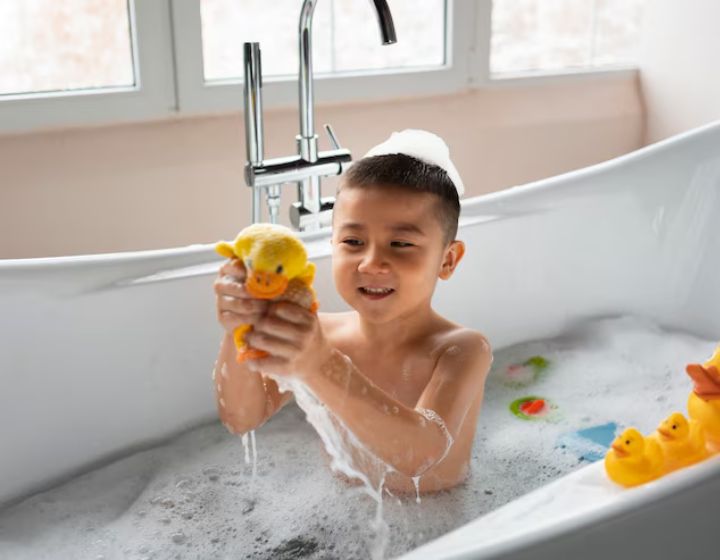
Ability: Does your child have the physical coordination to stand steadily in the shower and handle the showerhead?
Capability: Can they understand bathroom safety? For example, mixing hot and cold water safely and avoiding water play near electrical appliances.
Curiosity: Are they asking questions about their bodies and showing signs of self-awareness?
Confidence: Are they expressing the desire to bathe themselves, perhaps starting with soaping or rinsing?
While I worried whether my son could clean his back properly or dry himself thoroughly, I knew I had to support this milestone while treasuring the memories we had built.
Why is bath time more than just hygiene?
For toddlers, bath time is about splashing and playing. For older children, it transforms into an important lesson in independence, body respect, and personal boundaries. These are crucial for their self-esteem and body positivity, especially as they approach puberty.
With my son, we took it step by step—starting with washing his legs and stomach, then moving to his face and tricky back. By age six, he was confidently managing his bath time, and I felt a mix of pride and bittersweet nostalgia.
Read more: Why You Shouldn’t Force Kids To Give Hugs
How can parents navigate this transition?
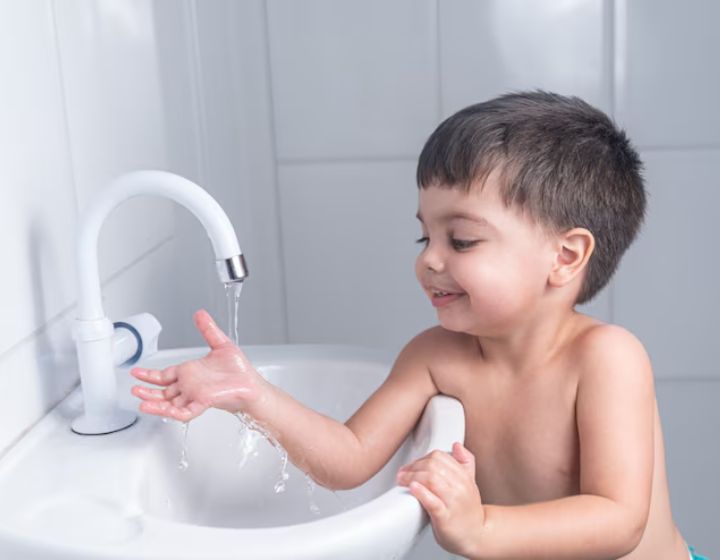
Take Small Steps: Introduce independent tasks early, like soaping their body (ages 3 to 5), washing their body but not hair (ages 6 to 8), and gradually building up to full independence by age 9-12.
Have Conversations: Respect their readiness. If they express interest, encourage them. If not, gently ask how they feel about starting.
Provide Support: Equip them with age-appropriate tools like anti-slip mats, light towels, and visual checklists to remind them of the steps.
Be Nearby: Stay close enough to assist if needed, especially during the early stages.
Cultural differences and individual preferences play a role in this transition. Remember to adapt based on your child’s personality and developmental pace.
Bathing is a milestone in the Parent-Child Journey.
I will always cherish the splashes and giggles of bath time. But as my son grows, our bonding moments have shifted. Now, we enjoy long walks, cosy reading sessions, or lazy afternoons at the pool.
Letting go of caregiving responsibilities can be bittersweet, but it’s also an act of love. So, the next time your child says, “I can do it myself,” take a deep breath and let them try. You’re not just teaching them independence; you’re strengthening your bond in new ways.






 View All
View All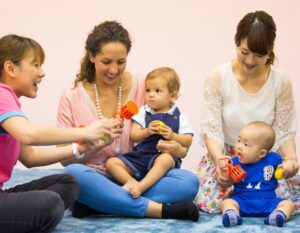





 View All
View All










 View All
View All


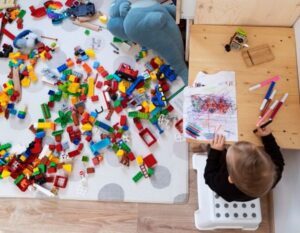


![[𝗛𝗢𝗧 𝗡𝗘𝗪𝗦] $𝟭𝟬𝟬 𝗦𝗚 𝗖𝘂𝗹𝘁𝘂𝗿𝗲 𝗣𝗮𝘀𝘀 = 𝗙𝗿𝗲𝗲 / 𝗰𝗵𝗲𝗮𝗽𝗲𝗿 𝗮𝗰𝗰𝗲𝘀𝘀 𝘁𝗼 𝟰𝟬𝟬+ 𝗮𝗿𝘁𝘀 & 𝗵𝗲𝗿𝗶𝘁𝗮𝗴𝗲 𝗲𝘃𝗲𝗻𝘁𝘀 𝗶𝗻 𝗦𝗶𝗻𝗴𝗮𝗽𝗼𝗿𝗲 🎭✨ 🎨🎶📚
Big news for all culture vultures! From 1 Sept 2025, every Singapore Citizen aged 18 & above will receive $100 in SG Culture Pass credits to explore over 400 arts & heritage events across the island.
✅ Valid for 3 years (till 31 Dec 2028)
✅ Use for performances, exhibitions, workshops, learning tours & more
✅ Covers literary arts, theatre, music, dance, visual arts & heritage experiences
✅ Credits can be used for your family & friends’ tickets too
This first-of-its-kind scheme was announced in Budget 2025, with $300 million set aside to spark new audiences for Singapore’s arts & heritage scene.
Comment “Culture” or hit the link in bio to see what’s in store for families with kids from capped childcare fees to CDC vouchers, SG60 vouchers, SG60 baby gifts and more!
.
.
.
.
.
#SGCulturePass #SingaporeArts #SingaporeCulture #SGEvents #SGHeritage #ThingstoDoSG #SingaporeNews #ArtsInSG #CultureInSG #ExploreSG
](https://www.sassymamasg.com/wp-content/plugins/instagram-feed/img/placeholder.png)
